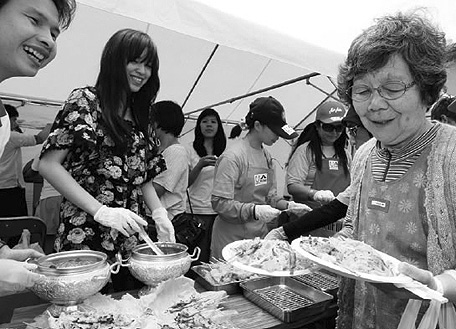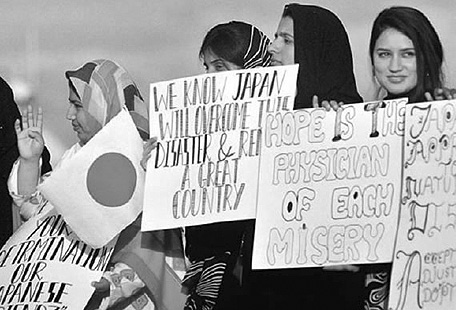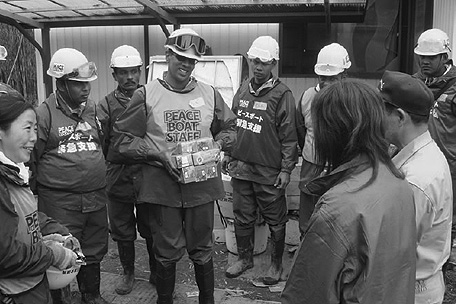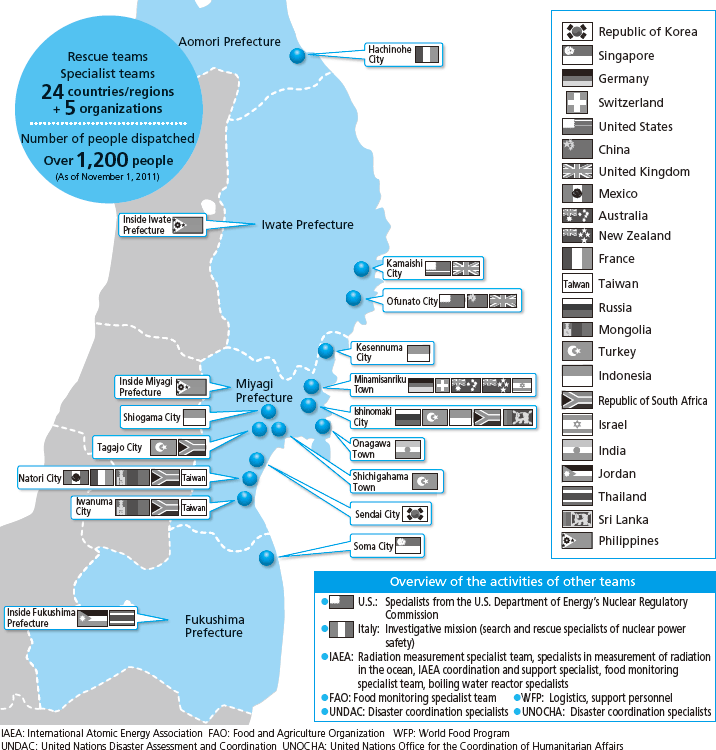Japan's Official Development Assistance White Paper 2011
Section 1 Support Reaching Affected Areas from Countries Around the World
Immediately after the earthquake, many countries in the world began extending a hand of support to the affected areas. In the two months following the earthquake, emergency aid and medical support teams from 23 countries and regions overseas visited the affected areas. The teams that came to Japan not only cooperated with Japanese police, firefighters, and military to conduct efforts that included search and rescue, provision of medical treatment, removal of rubble, but also worked to overcome language barriers and interact with local residents, giving them much courage and encouragement.
Particularly, the rapid, large-scale support provided by the United States displayed the solid bond and deep trust between the two countries. Late at night on the day of the earthquake, President Obama told Prime Minister Kan that the U.S. was ready to provide all possible assistance. The U.S. Forces immediately launched operations to aid the affected areas, which included large-scale aid activities such as searching for missing people, transporting relief goods, and providing power supply/water supply trucks. These activities were dubbed "Operation Tomodachi" ("Operation Friend"), and at its peak involved approximately 25,000 personnel, 24 ships, and 189 aircraft. The hearts of the Japanese people have been deeply touched by the dedicated support of the U.S.

Prime Minister Yoshihiko Noda expresses his gratitude for support from the international community and his determination for Japan's recovery, at a meeting of the UN General Assembly (Photo: Cabinet Public Relations Office)
The support, solidarity, and words of encouragement from locations around the world have reached victims in Japan in a variety of forms. Republic of Korea (ROK) dispatched rescue dog teams on the day after the earthquake, and two days later, additional members were sent, amounting to 107 members overall. They engaged in a rescue operation in Sendai City. On the day before the Japan-China-ROK Trilateral Summit was held in Japan in May, Chinese Premier Wen Jiabao and the President of the ROK Lee Myung-bak offered flowers at the affected area in Miyagi Prefecture, then with Prime Minister Kan visited an evacuation center in Fukushima Prefecture to offer sympathy to the victims. The Electricity Generating Authority of Thailand loaned, free of charge, two generators and peripheral equipment to Tokyo Electric Power, which was suffering from insufficient power supply capacity. Blankets, nonperishable food, and many other goods even arrived from the geographically distant countries of Central and South America. In addition, meetings and charity events to support victims were held in Europe and other locations around the world to collect monetary donations.

Volunteers from ASEAN countries provide meals in Ishinomaki City, Miyagi Prefecture

U.S. military helicopters head off to deliver supplies to affected areas, as part of America's "Operation Tomodachi (Friends)" (Photo: U.S. Navy Photo)
Japan’s recovery has not only been assisted by the developed world, but has received much warm support from many developing countries as well.
A Japanese aid organization that provides assistance for school lunches in the West African nation of Sierra Leone received a donation of $500 collected by students at local schools. Although the students themselves had a difficult time getting one sufficient meal a day, they sold vegetables and mangos—their own food—to earn money to donate. Donations poured into Japanese embassies and consulates around the world, from many citizens of those countries who took from the income they needed for their own support, with the message that they wanted to help the victims in Japan.

Students hold a meeting to express their condolences and sense of solidarity toward the disaster victims (Pakistan)
Many of those messages expressed gratitude toward Japan, for assistance they received when they themselves were victims, or for Japan's support for the development of their countries. Cemil Cicek, Deputy Prime Minister of Turkey at that time, which sent a rescue team and provided blankets and other goods, said "We share the pain of our friends in Japan, and confident that Japan will be able to heal its wounds in a short time. We are prepared to contribute to that healing in any way possible. We have not forgotten that Japan and the Japanese people extended a hand of support after the earthquake that we suffered in 1999."
In addition, a group of Muslims from a variety of countries in Asia, Africa, and the Middle East living in Kanagawa Prefecture procured food and relief supplies, found a means of transportation, and made the rounds, particularly focusing on small, isolated evacuation centers in Kesennuma City, Rikuzentakata City, Ofunato City, and the Town of Minamisanriku, cooperating with Japanese volunteers to provide emergency meals of curry for thousands of people eight different times. They spoke of their motivation as follows. "On December 26, 2004, a major earthquake occurred just off the coast of Sumatra. An enormous tsunami struck Sri Lanka, home to some of us, taking the lives of over 50,000 people. The first ones to come and help us at that time were the people of Japan. It was the same when disasters occurred in Pakistan and Indonesia. It was also the people of Japan who constructed schools and hospitals, and built harbors and bridges, in our countries. Seeing the heartbreaking suffering of the Japanese people caused by this great disaster, we discussed what we could do to help. We decided to take hot food to people enduring the cold at evacuation centers. The people of Japan are all our brothers and sisters. Our desire to pay our debt of gratitude and to do something—anything at all—to help the victims of the disaster moved us to action."

A relief team from Sri Lanka provides recovery assistance with the NGO Peace Boat in Ishinomaki City, Miyagi Prefecture. Here they present a gift of Sri Lankan tea to affected people.

Notes of encouragement from students in the Japanese Studies Department at Vietnam National University, Hanoi (Vietnam)

An Israeli medical team provides medical care to residents of affected areas in Minamisanriku Town, Miyagi Prefecture
The location of assistanc e activities of rescure teams and specialist teams from foreign countries, regions, and international organizations (as of September 2011)

